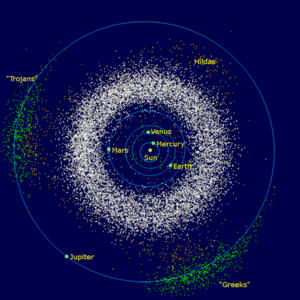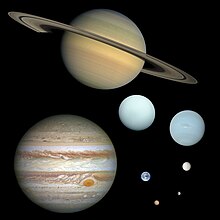

| Sun Jupiter trojans Orbits of planets | Asteroid belt Hilda asteroids (Hildas) Near-Earth objects (selection) |

| Sun Jupiter trojans Giant planets: Centaurs | Neptune trojans Resonant Kuiper belt Classical Kuiper belt Scattered disc |
Solar System belts are asteroid and comet belts that orbit the Sun in the Solar System in interplanetary space.[1][2] The Solar System has both major and minor asteroid and comet belts in the inner Solar System. The Solar System is unique in that it has multiple belts. The observation of other planetary systems has found these systems to have no asteroid belts or one vast asteroid belt. The stars Fomalhaut, HD 69830 and Epsilon Eridani are examples of systems with one large asteroid belt.[3][4][5] The Solar System belts size and placement are mostly a result of the Solar System having four gas giant planets: Jupiter, Saturn, Uranus and Neptune far from the sun. The gas giant planets must be in the correct place, not too close or too far from the sun for a system to have Solar System belts.[6][7][8]
Formation[edit]
The Solar System belts were formed in the formation and evolution of the Solar System.[9][10] The Grand tack hypothesis is the theory of the unique placement of the gas giants and the Solar System belts.[6][7][11] Most gas giant planets found outside our Solar System, exoplanets, are inside the snow line, and are called Hot Jupiters.[8][12] Thus in normal planetary systems gas giants form beyond snow line and then migrated towards the star. A small percent of gas giants migrate far from the star. In both types of migrations, the Solar System belts are lost in these planetary migrations. The Grand tack hypothesis explains how in the Solar System gas giants migrated in unique way to form the Solar System belts and near circular orbit of planets around the Sun.[13][14][12] The Solar System's belts are one key parameters for a Solar System that can support complex life, as circular orbits are a parameter needed for the Habitable zone for complex life.[15][16] [17][18]
Solar System belts[edit]
The asteroid and comet belts orbit the Sun from the inner rocky planets into outer parts of the Solar System, interstellar space.[19][20][21] An astronomical unit, or AU, is the distance from Earth to the Sun, which is approximately 150 billion meters (93 million miles).[22] Small Solar System objects are classified by their orbits:[23][24]
- Apollo asteroids, small group of Near-Earth objects, 0.5 to 1.017 AU
- Amor asteroids, small group of Near-Earth objects, 1.017 AU to 1.3 AU
- Mars trojans small group around Mars orbit 1.3 to 1.6 AU
- Hungaria asteroids, small group, 1.78 to 2.00 AU
- Main Asteroid belt (main belt), between Mars and Jupiter, in near circular orbit, 2.2 and 3.2 AU
- Alinda asteroids, small group, 2.5 AU in elliptical orbits
- Hilda asteroid small group just inside Jupiter, 4.0 AU
- Jupiter trojan (Greeks asteroid) small group near Jupiter's orbit, 5.05 to 5.35 AU
- Centaur belt icy planetoids, between Jupiter and Neptune, 5.2 to 30.1 AU
- Scattered belt small group, 21.5 to 215 AU
- Kuiper belt large belt, 43 to 64.5 AU
- Trans-Neptunian object >30 AU
- Sednoid (inner Oort cloud objects) small group of four or more, high elliptical orbits, 47.8 to 80 AU
- Oort cloud a large belt, 107.5 to 2,1505 AU (interstellar space)
Planets[edit]


Solar System planets and dwarf planets listed for distances comparison to belts. The Solar System planets are all in near circular orbit.[25][26][27]
Planets:
- Mercury 0.39 AU
- Venus 0.72 AU
- Earth 1 AU
- Mars 1.52 AU
- Jupiter 5.2 AU
- Saturn 9.54 AU
- Uranus 19.2 AU
- Neptune 30.06 AU
Dwarf planets:
Dwarf planets, other than Ceres, are plutoids that have elliptical orbits:[28][29][30]
- Ceres, 2.8 AU in the asteroid belt
- Orcus 39.4 AU, Trans-Neptunian-Kuiper belt object
- Pluto 39 AU, Kuiper belt (a planet until 2006)
- 120347 Salacia 42 AU, Trans-Neptunian-Kuiper belt object
- Haumea 43 AU, Kuiper belt
- Makemake 45.8 AU, Kuiper belt
- Eris 95.6 AU, Kuiper belt
- Gonggong Scattered disc object, 34 to 101 AU
- Quaoar Kuiper belt object, 41.9 to 45.4 AU
- Sedna 76 to 506 AU
See also[edit]
- Near-Earth object
- Planetary migration
- Late Heavy Bombardment
- List of gravitationally rounded objects of the Solar System
- List of Solar System objects by size
- Lists of geological features of the Solar System
- List of Solar System extremes
- Outline of the Solar System
References[edit]
- ^ "Asteroids, Comets & Meteors". science.nasa.gov.
- ^ "Comets". science.nasa.gov.
- ^ "Alien Asteroid Belt Compared to our Own". Exoplanet Exploration: Planets Beyond our Solar System.
- ^ "Nearest planetary system boasts two asteroid belts". New Scientist.
- ^ "Absolutely enormous asteroid belt discovered around a nearby star". New Scientist.
- ^ a b Zubritsky, Elizabeth. "Jupiter's Youthful Travels Redefined Solar System". NASA. Retrieved 4 November 2015.
- ^ a b Beatty, Kelly (16 October 2010). "Our "New, Improved" Solar System". Sky & Telescope. Retrieved 4 November 2015.
- ^ a b Sanders, Ray (23 August 2011). "How Did Jupiter Shape Our Solar System?". Universe Today. Retrieved 4 November 2015.
- ^ Deienno, Rogerio; Gomes, Rodney S.; Walsh, Kevin J.; Morbidelli, Alessandro; Nesvorný, David (2016). "Is the Grand Tack model compatible with the orbital distribution of main belt asteroids?". Icarus. 272: 114–124. arXiv:1701.02775. Bibcode:2016Icar..272..114D. doi:10.1016/j.icarus.2016.02.043. S2CID 119054790.
- ^ Raymond, Sean (2 August 2013). "The Grand Tack". PlanetPlanet. Retrieved 7 November 2015.
- ^ Fesenmaier, Kimm (23 March 2015). "New research suggests Solar system may have once harbored super-Earths". Caltech. Retrieved 5 November 2015.
- ^ a b Choi, Charles Q. (23 March 2015). "Jupiter's 'Smashing' Migration May Explain Our Oddball Solar System". Space.com. Retrieved 4 November 2015.
- ^ O'Brien, David P.; Walsh, Kevin J.; Morbidelli, Alessandro; Raymond, Sean N.; Mandell, Avi M. (2014). "Water delivery and giant impacts in the 'Grand Tack' scenario". Icarus. 239: 74–84. arXiv:1407.3290. Bibcode:2014Icar..239...74O. doi:10.1016/j.icarus.2014.05.009. S2CID 51737711.
- ^ Matsumura, Soko; Brasser, Ramon; Ida, Shigeru (2016). "Effects of Dynamical Evolution of Giant Planets on the Delivery of Atmophile Elements during Terrestrial Planet Formation". The Astrophysical Journal. 818 (1): 15. arXiv:1512.08182. Bibcode:2016ApJ...818...15M. doi:10.3847/0004-637X/818/1/15. S2CID 119205579.
- ^ "Asteroid Belts of Just the Right Size are Friendly to Life". science.nasa.gov.
- ^ Space com Staff (November 2, 2012). "Alien Life May Require Rare 'Just-Right' Asteroid Belts". Space.com.
- ^ Ramirez, Ramses M. (May 4, 2020). "A Complex Life Habitable Zone Based On Lipid Solubility Theory". Scientific Reports. 10 (1): 7432. Bibcode:2020NatSR..10.7432R. doi:10.1038/s41598-020-64436-z. PMC 7198600. PMID 32366889.
- ^ "The "Rare Earth" Hypothesis, by John G. Cramer". www.npl.washington.edu.
- ^ "Asteroid and Comet Census from WISE" – via www.jpl.nasa.gov.
- ^ "Small-Body Database Lookup". ssd.jpl.nasa.gov.
- ^ RESOLUTION B5 – Definition of a Planet in the Solar System (IAU)
- ^ On the re-definition of the astronomical unit of length (PDF). XXVIII General Assembly of International Astronomical Union. Beijing, China: International Astronomical Union. 31 August 2012. Resolution B2.
... recommends ... 5. that the unique symbol "au" be used for the astronomical unit.
- ^ "Asteroid Watch". NASA Jet Propulsion Laboratory (JPL).
- ^ "Asteroid Fast Facts - NASA". March 31, 2014.
- ^ "Solar System Sizes and Distances, jpl.nasa.gov" (PDF). Jet Propulsion Laboratory.
- ^ Grossman, Lisa (24 August 2021). "The definition of planet is still a sore point – especially among Pluto fans". Science News. Archived from the original on 10 July 2022. Retrieved 10 July 2022.
- ^ Lakdawalla, Emily (21 April 2020). "What Is A Planet?". The Planetary Society. Archived from the original on 22 January 2022. Retrieved 3 April 2022.
- ^ "Planets". science.nasa.gov.
- ^ "In Depth | 4 Vesta". NASA Solar System Exploration. Archived from the original on February 29, 2020. Retrieved February 29, 2020.
- ^ "Hubble Observes Planetoid Sedna, Mystery Deepens". NASA's Hubble Space Telescope home site. April 14, 2004. Archived from the original on 2021-01-13. Retrieved January 26, 2008.

